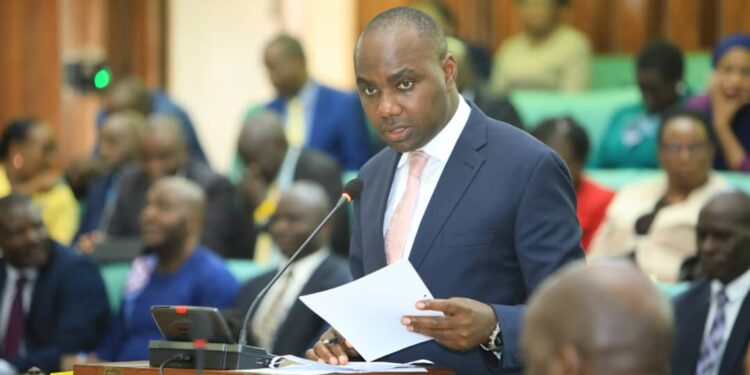Henry Musasizi, the Minister of State for Finance, has disclosed that the Uganda Revenue Authority (URA) is projected to gather taxes amounting to Shs31.574 trillion to support the 2024/25 national budget. This marks a rise of Shs1.9 trillion from the current target of Shs29.672 trillion set for the fiscal year 2023/24.
These particulars were disclosed by the Minister on Thursday in his testimony before the Finance Committee of the Parliament. He served as the delegation leader for the Uganda Revenue Authority (URA), which was presenting its plans and budget estimates for the 2024–2025 fiscal year.
In addition, Musasizi stressed that the Uganda Revenue Authority (URA) will continue to carry out reforms in order to achieve the anticipated tax collection target. This covers the implementation and enforcement of electronic invoicing and receipt systems. “This reform’s goal is to make sure taxpayers keep accurate records, file their returns on time, and quickly determine their VAT obligations,” he said. I implore all Ugandans to support this endeavor. The government and taxpayers will both gain from these measures, which are intended to improve the tax system’s efficiency, compliance, and openness.
The Minister went on to say that the newly proposed taxes, which target industries like land transactions, petroleum, and cement, are intended to bring in an extra Shs1.902 trillion in income. These suggestions are a component of the government’s calculated attempts to increase tax revenue collection and assist with important development programs that are listed in the national budget.
However, Agnes Apea (Amolatar DWR) expressed skepticism about URA’s ability to achieve this target, citing the Authority’s recent history of revenue shortfalls. She questioned the strategies URA plans to employ to successfully collect such a significant amount of money.
“What is new and what is really magical that you are going to do to raise the expectation of this country that you are going to raise additional Shs1.9 Trn? I think that will put us at risk. We are better off maintaining the revenue that we generated last year because after all, we have never seen a year that we have achieved a surplus of 2%. I have a problem of over exaggerating our projections and for me, that is where the problem comes from,” she said.
During the meeting of the Finance Committee of Parliament, Jane Avur, the Vice Chairperson, expressed her worries too. She pointed out that, according to the Commissioner General’s report, just Shs 19 trillion had been collected so far this year, despite the yearly revenue collection target being around Shs 29.6 trillion.
Avur underlined how urgent the situation is and how URA must act quickly to implement corrective measures in order to close the deficit and fulfill the deadline of June 2024. She emphasized that meeting this revenue target is necessary to fulfill government commitments and a number of sectors initiatives, underscoring the significance of efficiently resolving any deficiencies. The importance of achieving income objectives for the effective implementation of government programs and commitments was highlighted by Avur’s thorough statements.
Will it be possible?
Uganda’s tax base seems to be deepening rather than expanding as a result of the introduction of new taxes. The transportation industry is expected to be significantly impacted by the introduction of taxes, especially fuel-related levies. Consequently, local firms will probably be impacted as their production costs will rise. Local producers might also have to compete with foreign investors who enjoy tax breaks, which would mean that the latter had comparatively lower manufacturing costs. This case illustrates the difficulties and complexities that could result from shifting tax laws and how they affect different economic sectors, especially with regard to cost structures and competitiveness.
There’s also the issue of the recently implemented cement building tax. Given that construction is a sector that employs a sizable number of people, it is anticipated that this additional tax will have an impact on the broader public. Building project participants, including people and corporations, may face higher construction costs as a result of the new tax’s increased cement cost. This circumstance emphasizes how intertwined tax laws are, how they affect different economic sectors, and how they affect jobs and means of subsistence.
It is difficult to reach the anticipated tax revenue projections because of the small industrial base, which accounts for only 25 percent of the GDP, and the predominantly service sector, which accounts for 55 per cent. In addition, the tax system is made more difficult by the economic structure, which sees a large percentage of the population living in rural areas and depending on unofficial economic activity. There are justifiable doubts over the viability of reaching the anticipated tax revenues given the demographic profile marked by a high dependency ratio.
Given the primarily informal nature of economic activity in rural areas and the difficulties in enforcing tax laws in such settings, this situation raises concerns about the sources and mechanisms through which the anticipated taxes will be generated. To tackle these obstacles, a thorough grasp of the workings of the economy is necessary, as is the creation of plans designed to maximize tax compliance with the least amount of negative effects on vulnerable groups of people.
Do you have a story in your community or an opinion to share with us: Email us at editorial@watchdoguganda.com














